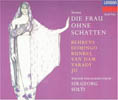Die
Frau ohne Schatten
at the Los
Angeles Opera...
a magical celebration of procreation
Other Strauss Operas on FanFaire
Elektra
Salome
BUY AWARD-WINNING CD of
Die Frau ohne Schatten *

Los Angeles Opera in FanFaire:
The Grand Duchess
Pagliacci
Orfeo ed Euridice
Die Frau ohne Schatten
Giulio Cesare
I Capuleti e i Montecchi
Samson et Dalila
Madama Butterfly
Salome
La Bartoli IN LA
Susan Graham in Recital
Placido Domingo at LA Opera
Richard Leech at LA Opera
SITEMAP
Sign
up:
EMAIL UPDATE
GIVEAWAY!
![]()
FANFAIRE
Store
of Books & Music
![]()
USA
UK
DE
FR
Buy
sheet music
![]()
Some say that Die Frau ohne Schatten (or "The Woman without
a Shadow") is Richard Strauss' greatest opera. If you saw
Los Angeles Opera's magnificent revival of its 1993 production, carried
out to near vocal, orchestral, and visual perfection under Kent Nagano's
masterful baton and in the magical environment of David Hockney's* stage
sets, chances are you went home after the show at least half convinced
that it is so. Especially if you're not a first timer to opera and can
sit absorbed for hours (4 in the cut LA version; 5 in others) in Strauss'
hauntingly beautiful music while working out in your mind the sometimes
opaque, sometimes amusing, symbolism of the fairy tale being played out
onstage.
Fairy tale? Yes! but as presaged by the ominous opening bars of the score, of a completely different order than say, Humperdinck's Hansel und Gretel, or its lyrical parallel - Mozart's Die Zauberflöte - from which the librettist Hugo Hoffmansthal admittedly drew some inspiration for this, his and Strauss' uncommonly elaborate paean to the progenitive consequences of conjugal bliss and the joys of motherhood. This is an opera about two couples whose relationships are marred by the absence of children (one because the woman, being half-spirit, is infertile or "without shadow;" the other for a more readily understable reason) who, following the earth-shattering resolution of individual internal conflicts (yes, there is an earthquake that swallows the Dyer and his wife), are in the end able to celebrate the prospect of woman's ultimate fulfillment - bearing many children (which was indeed the epitome of womanly fulfillment in the early 1900s when the opera was written). And as fairy tales go, they live happily ever after!
 Photos: © Robert Millard / with permission of Los Angeles Opera |
The tale's characters exist on three planes - spiritual, earthly, and in-between. Keikobad, ruler of the spirit world, is never seen, but it is his grim edict around which the story unfolds. It is delivered on the night of the twelfth moon by a Spirit-Messenger (baritone) in radiant blue armor, to the Nurse (Doris Soffel, mezzo-soprano) whose ward is the Empress (Inga Nielsen, soprano), Keikobad's daughter by a human and now the still childless wife of the Emperor (Robert Dean Smith, tenor). The Empress is his greatest hunting prize: a gazelle, struck by a red falcon, had turned into a woman in his arms. |
| The
edict: If the Empress still does not cast a shadow within three days,
the Emperor will be turned to stone ("Er
wird zu Stein," - © GCajipe /FanFaire |
|
| next >>> | |
*DAVID HOCKNEY is perhaps the most famous of English contemporary painters. An eclectic and prolific artist who first made his mark in Pop Art, he has produced numerous works in almost every medium. His innovative set designs for the stage of the world's major opera houses are the subject of the recently released and acclaimed documentary film "The Colors of Music" by MARYTE KAVALIAUSKAS and SETH SCHNEIDMAN. He is also a distinguished author whose recent book on the use of optical devices by the old masters of Western art caused quite a stir among art historians.
AWARDS: 1992 Grammy Award for Best Opera Recording; 1992 Gramophone Award for Best Opera Recording; 1992 Shortlisted for Gramophone Award for Record of the Year; Awarded the Coveted Penguin Guide Rosette; The Most Expensive Record Ever Made when it was undertaken in 1989/90/91; Stella Award - Brimingham. BUY THE CD!
Windows Media Player required to hear the music clip.
| Home | Store | MusicPlanner | New Releases | Food & Music | AudioFiles | SiteMap | EmailUpdate |
All rights reserved.